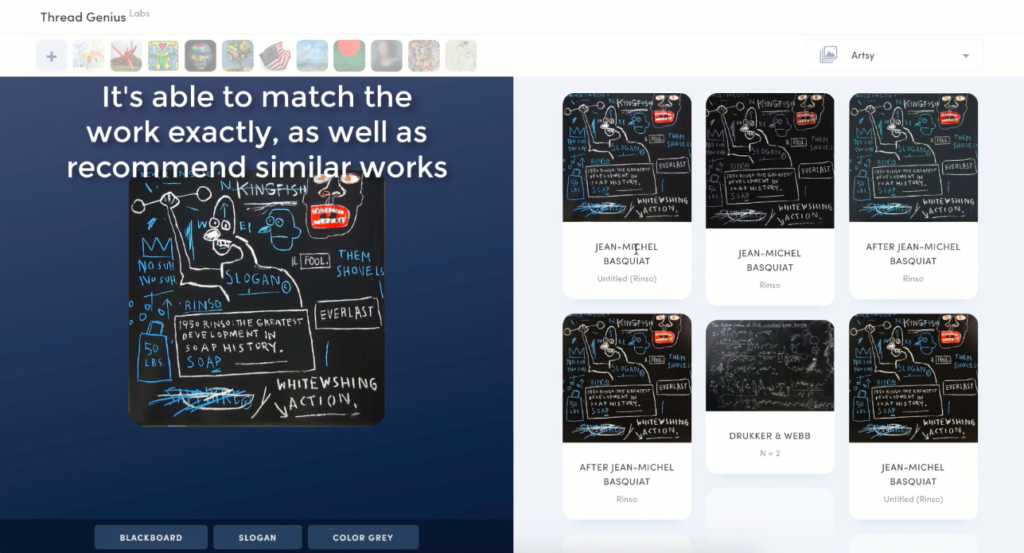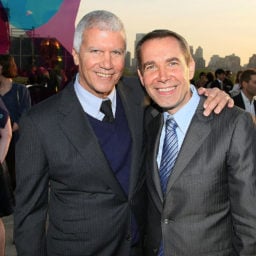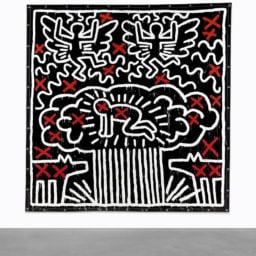Every Monday morning, artnet News brings you The Gray Market. The column decodes important stories from the previous week—and offers unparalleled insight into the inner workings of the art industry in the process.
This week, stories about the prospects and perils of expanding one’s audience…
THREADING THE PADDLE
On Thursday came the latest in an ongoing series of acquisitions aimed at evolving what used to be an auction house into a 360-degree art services platform. That was the day Sotheby’s announced it had bought Thread Genius, a startup whose killer app Ingrid Lundgren at TechCrunch described as “a set of algorithms that can both instantly identify objects and then recommend images of similar objects to the viewer.”
In other words, one of the world’s top two auction houses will soon be using the same type of machine learning that powers Artsy’s Art Genome project, as well as Netflix and Amazon’s ability to serve up a never-ending buffet of options broadly similar to what we’ve already nibbled at (or binged on).
While this seems like a sensible acquisition to me—especially since Thread Genius’s price was low enough to be considered “non-material to [Sotheby’s],” per Lundgren—I think it’s important to consider its limitations for the art market.
Recommendation engines tend to be most valuable in cases where cost savings matter and buyers aren’t particularly loyal to their first choice. For example, if I’m just looking to kill a couple hours on a Saturday after I’ve spent the past month watching classic American gangster movies, I’m pretty likely to say “Why the hell not?” if Netflix suggests I might like to stream a foreign crime thriller that I’ve never heard of.
The same idea plays out if I’m looking to buy, say, a stainless steel skillet on Amazon. If I click on a Cuisinart, then scroll down to the list of similar items and see an Emeril Lagasse signature model that’s five bucks cheaper, there’s a good chance I’ll go with the latter option.
To Frankenstein together terms from retail and economics, people are generally willing to make substitutions like the ones above because the things in question are not brand elastic. This basically means we’re unlikely to stretch ourselves away from the decision to consume them even in light of a drastic change in their maker.
Why? Because in the end we’re still getting something that serves our needs nearly or equally well as what came before, and possibly at a better price.
So to return to our examples, I might take a chance on a previously unknown film like Gomorrah because it still plays on similar themes, aesthetics, and dramatic tensions as The Godfather trilogy. Plus, the cost of checking it out is zero. And I might cop an Emeril skillet because it’s probably going to allow me to fry eggs just as well as the Cuisinart—and, bonus, it’s cheaper!
But once you get past the entry level, this is not how the art market works.
For instance, say I’m a collector interested in paying about $7 million to acquire a gold Rudolf Stingel. If a Sotheby’s specialist were to suggest I pivot to paying a fraction of that amount for a silver Jacob Kassay, I’d look at them like they just asked me to consider adopting a sewer alligator.
Sure, we can draw visual parallels between the two works. Both are contemporary, non-figurative paintings. Both are made using precious metals. You may even be able to find two that are the exact same dimensions.
But each work’s maker matters more than any of these visual or material parallels, because the artist is the value proposition. Authorship determines the piece’s social capital, prestige level, and likely resale price, if not also its craftsmanship level and aesthetic depth. And those factors are what art collecting is all about.
This brand inelasticity applies to both true connoisseurs and COINs (Collectors Only In Name): the former because they’re primarily buying based on art-historical knowledge and taste level, the latter because they’re primarily buying based on what’s hot in the market right now (or alleged to be hot soon). Both groups know what they want, and substitutes generally won’t do.
In that sense, if Sotheby’s used Thread Genius to offer an alternative work to members of either of these groups, it would be a little like offering a can of shower cleaner to someone whose house is in flames because, hey, just like a fire extinguisher, this cylinder also sprays white foam out of a nozzle!
Again, that’s not to say Thread Genius won’t be useful. I just think it’s telling that the demo video included with Sotheby’s press release features this prompt:
“Imagine if you were decorating a house, and [Thread Genius] was able to recommend works to go with furniture…IT CAN.”
This scenario proceeds from a way of thinking about art buying that only works when the people doing the buying either don’t care all that much about what they end up with, or don’t know enough to be more discriminating.
Novice buyers like this are an important part of the art market. It’s smart for Sotheby’s to try to serve them better in both the short term (for quick cash) and the long term (if they get hooked on collecting).
Let’s just not gas ourselves into thinking that this bit of machine learning will fundamentally change the business. Thread Genius will sew a few new accessories onto the fringes of the art-sales space, but it’s unlikely to alter the underlying fabric.
[TechCrunch]
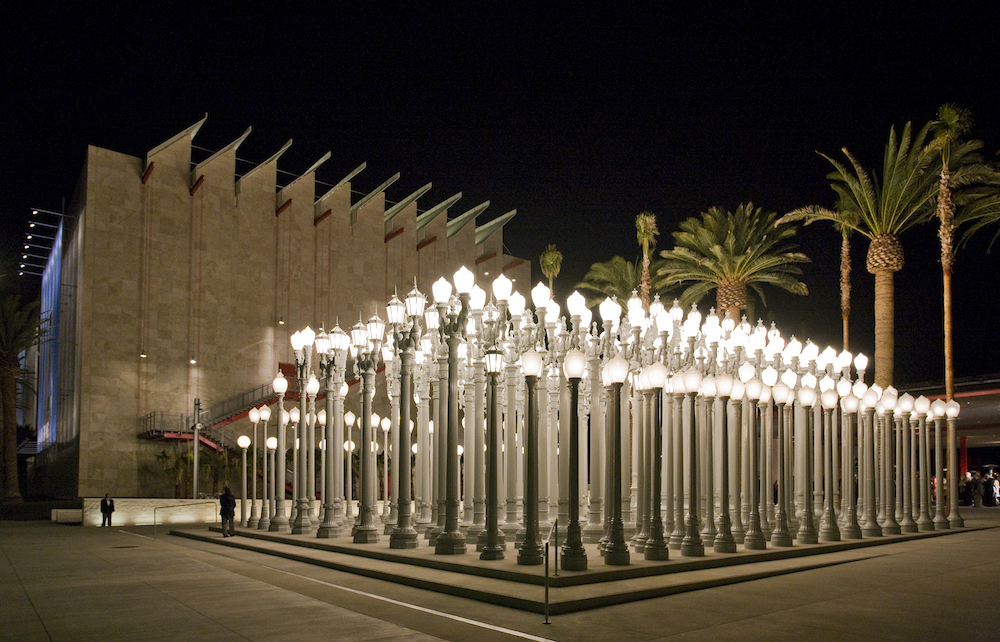
Chris Burden’s Urban Light (2008) outside LACMA. Courtesy the Los Angeles County Museum of Art.
SOUTHERN REACH
On Wednesday, Jori Finkel detailed the Los Angeles County Museum of Art’s forward-thinking proposal to launch a satellite location in the underserved community of South LA. And although the city council unanimously approved the plan two days later, I’m slightly fearful that the unorthodox move—one that could (and, I think, should) make the museum a model for its peers—will eventually make it a target as well.
For context, I’ll tell you as a recent Los Angeles expat that one of the only ways in which Mid-Wilshire, the district housing LACMA’s main campus, could be considered “underserved” is that the LA Fitness across the street isn’t yet open 24 hours a day.
In contrast, LACMA director Michael Govan told Finkel, “If you look at a map of LA’s public schools, the dots representing the neediest students are all through South Los Angeles.”
The council’s Friday vote tried to rebalance the scales by granting LACMA a 35-year lease on a disused former garage for city trains and buses, located in the South Los Angeles Wetlands Park. Per Curbed, the plan calls for the museum to ultimately “use up to 35,000 square feet in the 84,000-square-foot building for community-oriented arts programming,” with a 10,000 square-foot chunk of said space required to “open to the public in 18 months.”
Personally, I think this is a brilliant and well-informed initiative on LACMA’s part. As I wrote during the immediate uproar over the Met’s revised admission policy, a substantial body of research suggests that the best way for museums to reach underrepresented communities is to meaningfully engage them on each community’s terms. Eliminating ticket prices will not suddenly transform art crowds into the all-inclusive rainbow coalition depicted in most US college brochures.
The publicly available info about the Wetlands expansion suggests that it will chase these worthy goals through everything from its location to its ethos to its programming.
Still, there may be trouble bubbling deeper in the waters the proposal just sailed through. In Finkel’s piece, city councilman Curren D. Price, Jr. stated that the Wetlands building will be “part of a larger corridor for arts, recreation, and education” in the area.
Unless they were just modeling a tiny pink or blue knit hat in a hospital incubator yesterday, phrases like that one should put any activist’s gentrification radar on red alert.
And the neighborhood-watch sirens should only blare louder given that LACMA is also considering a possible second site elsewhere in South LA. This one would be part of an already-in-motion, 10-year renovation of Magic Johnson Park that could further expand the museum’s presence—or, as Finkel notes, “give Govan an alternative should members of either community not prove receptive.”
To be clear, early indications are that LACMA is pursuing its plans in a genuinely collaborative and culturally aware fashion. For instance, Finkel relayed that Darren Walker of the Ford Foundation, which has already granted LACMA $2 million toward its South LA ambitions, is “especially excited… by the museum’s plans to develop programs and exhibitions in consultation with community members instead of simply importing existing shows.”
Regardless of the museum’s sensitivities, however, LACMA’s southern reach is likely to set off a substantial makeover of South Los Angeles. What happens if and when the artisanal coffee shops and farm-to-table brunch joints start crowding around the Wetlands like white girls around a Coachella announcement?
We may be able to find possible comps in the ongoing controversy over Los Angeles’s gallery-anchored gentrification of Boyle Heights, as well as the smoldering discontent around the redevelopment of Chicago’s South Side via Theaster Gates’s Rebuild Foundation.
In these cases, elements within pre-existing communities have fought back against serious arts initiatives—even nonprofit ones—because of the demographic displacement and partitioning of city resources that tend to follow.
I have no doubt that LACMA and its partners have pored over these and other case studies while game-planning how to execute their own expansion. Here’s hoping that what they learned will allow them to come together—and stay together—with the South Los Angeles community for the permanent good of all involved.
[The New York Times | Curbed Los Angeles]
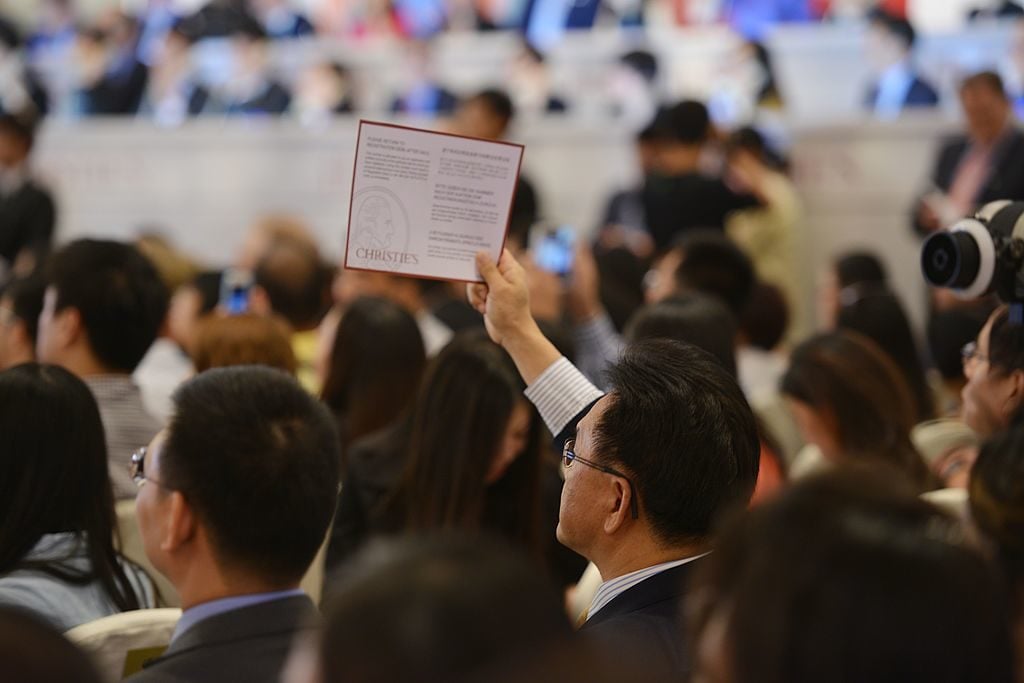
A bidder holds up his card at Christie’s inaugural auction in Shanghai on September 26, 2013. Courtesy Peter Parks/AFP/Getty Images.
DEADBID DADS
Finally this week, Georgina Adam took her excavating tools to the often-buried horrors of late payment and outright default by winning bidders at auction. And while many, if not most, geographical regions seem guilty of some negligence at all price bands, Adam’s sources emphasize the houses’ difficulties with one set of clients in particular.
Andrea Danese, CEO of Athena Art Finance, noted, “We are seeing a trend [of non-payment], notably with Chinese buyers. Exchange controls have been tightened up in the country, and some are unable to complete their purchases in a timely manner.”
Adam also cites statistics to this effect from The Art Market | 2017: an 11 percent rise in China’s non-payment rate over the previous two years, “from a low of 30 percent in 2013–14” to an unsettling 41 percent in 2015–16. An anonymous observer even told her that, culturally speaking, “In China, bidding is not always perceived as a legal obligation,” just the beginning of negotiations.
As my dad would say, “Yikes.”
Obviously, stating that many gallerists, dealers, and entrepreneurs are banking their hopes for future growth on the land of Xi Jinping would be about as insightful as stating that the average gallery press release has all the clarity of a transcript from a psychotic episode.
Nevertheless, there’s a larger market lesson to be learned from the anecdotal and quantifiable evidence about the auction houses’ payment problems with many Chinese buyers.
In my experience, an unhealthy cross-section of art sellers tends to bull-rush into new markets without seriously researching the actual differences between their new prospective clients and their old ones.
It doesn’t matter whether the would-be buyers in question hail from an unfamiliar region, age group, or professional sphere (see: the ongoing Bigfoot search for “the tech collector”). The impulse to grow often overrules the need to prepare.
I’m not saying the auction houses didn’t do their homework. Sometimes the pace of change in a demographic you knew well can undo even the best-laid plans. But that’s no excuse for refusing to draw up the blueprints in the first place.
[The Art Newspaper]
That’s all for this edition. ‘Til next time, remember: Reaching out doesn’t guarantee another outstretched hand will reach back.
